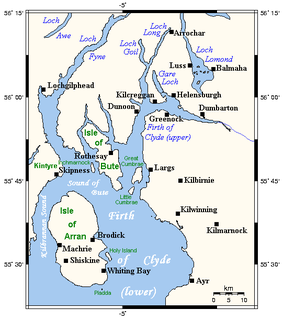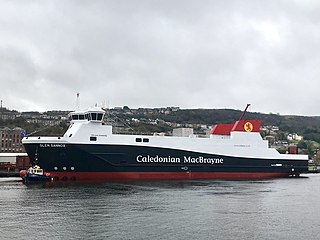
The Firth of Clyde is the mouth of the River Clyde and the deepest coastal waters in the British Isles, sheltered from the Atlantic Ocean by the Kintyre peninsula which encloses the outer firth in Argyll and Ayrshire. The Kilbrannan Sound is a large arm of the Firth of Clyde, separating the Kintyre Peninsula from the Isle of Arran. Within the Firth of Clyde is another major island – the Isle of Bute. Given its strategic location, at the entrance to the middle/upper Clyde, Bute played a vitally important military (naval) role during World War II.
Upper Clyde Shipbuilders (UCS) was a Scottish shipbuilding consortium, created in 1968 as a result of the amalgamation of five major shipbuilders of the River Clyde. It entered liquidation, with much controversy, in 1971. That led to a "work-in" campaign at the company's shipyards, involving shop stewards Jimmy Airlie and Jimmy Reid, among others.

Caledonian MacBrayne, usually shortened to CalMac, is the major operator of passenger and vehicle ferries, and ferry services, between the mainland of Scotland and 22 of the major islands on Scotland's west coast. Since 2006 the company's official name has been CalMac Ferries Ltd although it still operates as Caledonian MacBrayne. In 2006 it also became a subsidiary of holding company David MacBrayne Ltd, which is owned by the Scottish Government.
British Shipbuilders (BS) was a public corporation that owned and managed the shipbuilding industry in Great Britain from 1977 through the 1980s. Its head office was at Benton House in Newcastle upon Tyne, England.

Yarrow Shipbuilders Limited (YSL), often styled as simply Yarrows, was a major shipbuilding firm based in the Scotstoun district of Glasgow on the River Clyde. It is now part of BAE Systems Surface Ships, owned by BAE Systems, which has also operated the nearby Govan shipyard since 1999.

Ailsa Shipbuilding Company was a Scottish shipbuilding company based in Troon and Ayr, Ayrshire.
Seawind Barclay Curle is a British shipbuilding company.
Allied Shipbuilders Ltd is a privately held shipbuilding and ship repairing company established in Canada in 1948.
Lithgows Limited, is a family-owned Scottish company that had a long involvement in shipbuilding, based in Kingston, Port Glasgow on the River Clyde in Scotland. It has a continued involvement in marine resources.
Appledore Shipbuilders was a shipbuilder in Appledore, North Devon.

The Caledonian MacBrayne fleet is the largest fleet of car and passenger ferries in the United Kingdom, with 34 units in operation and another 2 under construction. The company provides lifeline services to 23 islands off the west coast of Scotland, as well as operating routes in the Firth of Clyde.
Hall, Russell & Company, Limited was a shipbuilder based in Aberdeen, Scotland.

MV Isle of Cumbrae is a Caledonian Maritime Assets Limited ro-ro car ferry, built in 1976 and operated by Caledonian MacBrayne. For ten years she was at Largs and operated the Loch Fyne crossing from 1999 to 2014. She was replaced by the MV Lochinvar in 2014, a new diesel-electric hybrid ferry capable of holding 23 cars and 150 passengers. She returned to Tarbert in 2016 after MV Lochinvar was moved to the Mallaig - Armadale station. She is now the oldest vessel in the Calmac fleet.
Cochrane Shipbuilders was a shipbuilder at Selby.

Caledonian Maritime Assets Limited owns the ferries, ports, harbours and infrastructure for the ferry services serving the west coast of Scotland, the Firth of Clyde and the Northern Isles.

MV Lochinvar is a pioneering diesel electric hybrid ferry built for Caledonian MacBrayne. Initially, she operated between Tarbert and Portavadie, was moved to the Mallaig to Armadale route in 2016 and currently operates on the Lochaline to Fishnish route. She is one of only three passenger and vehicle roll-on, roll-off ferries in the world to incorporate a low-carbon hybrid system of diesel electric and lithium ion battery power and is the second hybrid ferry commissioned and owned by Caledonian Maritime Assets. The ferries are sea-going and are 43.5 m (143 ft) long, accommodating 150 passengers, 23 cars or two HGVs. The first ferry, MV Hallaig, entered service on the Sconser to Raasay route in October 2013. The third sister ship, MV Catriona, entered service in 2016.

MV Catriona is a pioneering diesel electric hybrid passenger and vehicle roll-on, roll-off ferry built for Caledonian MacBrayne for the Claonaig - Lochranza crossing. She is the third hybrid ferry commissioned and owned by Caledonian Maritime Assets, one of three such ferries in the world to incorporate a low-carbon hybrid system of diesel electric and lithium ion battery power. The ferries are sea-going and are nearly 46 metres (150 ft) long, accommodating 150 passengers, 23 cars or two HGVs.

MV Glen Sannox is a dual-fuel car and passenger ferry for Caledonian MacBrayne, currently under construction at Ferguson Marine Engineering in Port Glasgow on the Clyde. The ship is expected to be in service from late 2021.

Hull 802 is a dual-fuel car and passenger ferry for Caledonian MacBrayne, currently under construction at Ferguson Marine Engineering in Port Glasgow on the Clyde.













